Cardiac Stress Training and Automated Blood Pressure Monitoring

What Is Cardiac
Stress Training?
Cardiac stress training is basically a process to
examine the heart health of the patient. It is performed to analyse patients for
the risk of a CVD i.e. cardio vascular disease.

In the cardiac stress training, the patient is made to
either walk on a treadmill or ride a stationary bike. Over time, the intensity
of the exercise is increased so that the patient’s heart requires more oxygen
and that it pumps harder.
This allows the doctors to study how the heart will
respond it the arteries are blocked or narrowed.During the course of this
examination, various factors of the patient, like the ECG waveforms, blood
pressure, and oxygen saturation are monitored.
Bruce Protocol is one of the most widely used cardiac
stress training. This protocol basically employs a treadmill and is a
combination of seven different stages. Each stage is 3 minutes long and varies
from the other in terms of the speed and inclination of the treadmill. The
treadmill is halted if the patient achieves the maximum permissible heart rate.
Most patients fail to move beyond the 3rd or 4th stage.
During a cardiac stress training, the blood pressure
is monitored at 2 minutes into each stage. It is crucial to get accurate
measurements of blood pressureto reach a valid diagnosis of CVD.
Disadvantages
Of Aneroid Blood Pressure Monitors
While most cardiac stress testing protocols still
employ a manual BP monitor, there are more than a handful disadvantages of
using the aneroid one.
1.
Environmental
Noise–During the treadmill test, there is great noiseand it
becomes difficult to differentiate between a korotkoff sound and a foot strike
on the treadmill. Hence the manual monitors may fail to alarm at the desired
times.
2.
Poor
Technique–Improper cuff size and rapid deflation rate may lead
to inaccurate readings of blood pressure during the cardiac stress testing. A
wrong cuff size can report afaultyincrease in the BP readings by 10mmHg.
3.
Patient
Focus–The manual BP monitors require too much time and
attention of the stress technician. This forces the stress tech to focus more on
the aneroid devicethan the patient and it is not favourable for the patient’s
well-being.
Why Opt For
Automated BP Monitor?
An automated blood pressure device is an ideal solution
to accurately measure a patient’s blood pressure during the cardiac stress
testing. It overcomes the difficulties of the manual monitor and helps in
accurately reporting of cardio vascular diseasesif any.
These automated monitors have been designed to enhance
the accuracy of BP measurements. They have settings for both frequency and
duration.Also, in a crisis situation when the stress technicianneeds to access
the BP readings, the automated machines fetchand display all past results for
comparison and proper analysis of the patient’s condition.
The AccuraPulse automated wrist
cuff blood pressure monitor is the most recommended one. It can be adjusted
to the patient’s wrist while he/she undergoes the cardiac stress testing. It
displays highly trusted blood pressure readings that the doctors can then use
to advise and prescribe medications to the CVD patients.
Post Your Ad Here
Comments